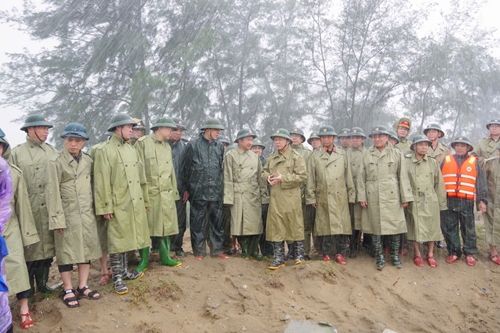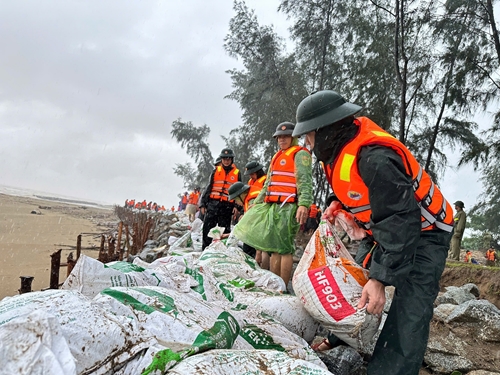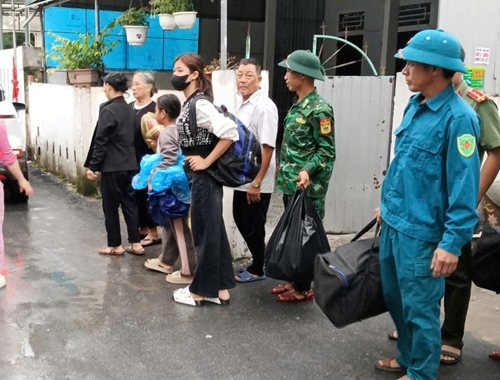    |
 |
|
Deputy Prime Minister Tran Hong Ha inspects Hoi Thong dyke in Dan Hai commune, Ha Tinh povince. |
At the command post of the National Civil Defense Steering Committee, Deputy Prime Minister Tran Hong Ha chaired an online meeting on the response work to the storm. Following the meeting, the Deputy Prime Minister inspected Hoi Thong dike in Ha Tinh, visited evacuees, and checked a school sheltering 62 households with 177 residents in Dien Chau commune of Nghe An province.
Given the forecast of destructive winds, high seas, and widespread flooding, thousands of households across Military Region 4 were urgently evacuated from danger zones.
    |
 |
|
Armed forces in Ha Tinh reinforce the dyke amidst strong winds and heavy rain ahead of the storm’s landfall. |
In Ha Tinh, which lay in the storm’s direct path, authorities relocated 8,247 households with nearly 19,400 residents from coastal and flood-prone areas. At Hoi Thong dike, where rising seas threatened 1,132 households, more than 200 soldiers, militiamen, and volunteer youth reinforced the embankment with sandbags and bamboo stakes under driving rain and gale-force winds.
In Nghe An, the provincial government imposed temporary road closures beginning late morning on August 25. All fishing boats had been brought ashore safely. In Truong Vinh ward, nearly 1,400 vulnerable households were evacuated to schools, clinics, and community houses stocked with food, water, and medicine. On the night of August 24, border guards in Quynh Phuong coordinated with local units to move hundreds of coastal families to safe shelters. Mountainous districts also evacuated residents overnight to avoid flash floods and landslides, with Muong Tip commune moving 17 households and Nhon Mai relocating about 1,000 people.
    |
 |
|
Troops in Cua Lo ward evacuate local residents to safe shelters. |
In Thanh Hoa, almost 60,000 coastal residents were evacuated with the support of the armed forces. By midday on August 25, nearly 2,000 households (over 7,000 people) had been moved inland. Authorities continued evacuations within a 200–500 meter strip along the shoreline to ensure safety. In mountainous communes, border guards and local officials prepared contingency plans for over 790 villages at risk of flash floods and landslides. Troops were deployed to reinforce vulnerable sites, block dangerous roads, and prevent people from entering high-risk areas. At evacuation centers, food, water, and medical care were readily prepared, with special attention given to the elderly, children, and pregnant women.
In Quang Tri, border guard units evacuated hundreds of families and reinforced schools and clinics serving as shelters. Nearly 2,000 households were relocated from landslide- and flood-prone areas, while workers at Lilama factories were transported out of danger under military escort through heavy rains.
    |
 |
|
Armed forces in Thien Can commune, Ha Tinh province, assist residents in evacuation efforts. |
On the late afternoon of August 25, the fifth storm made landfall in Nghe An and Ha Tinh. Fierce winds howled, waves crashed violently against sea walls, and seawater surged inland, flooding neighborhoods in Cua Lo of Nghe An. Authorities evacuated more than 3,800 residents to safe shelters, while fishing vessels were pulled ashore and secured. Offshore fish farms were ordered vacated.
Translated by Tran Hoai